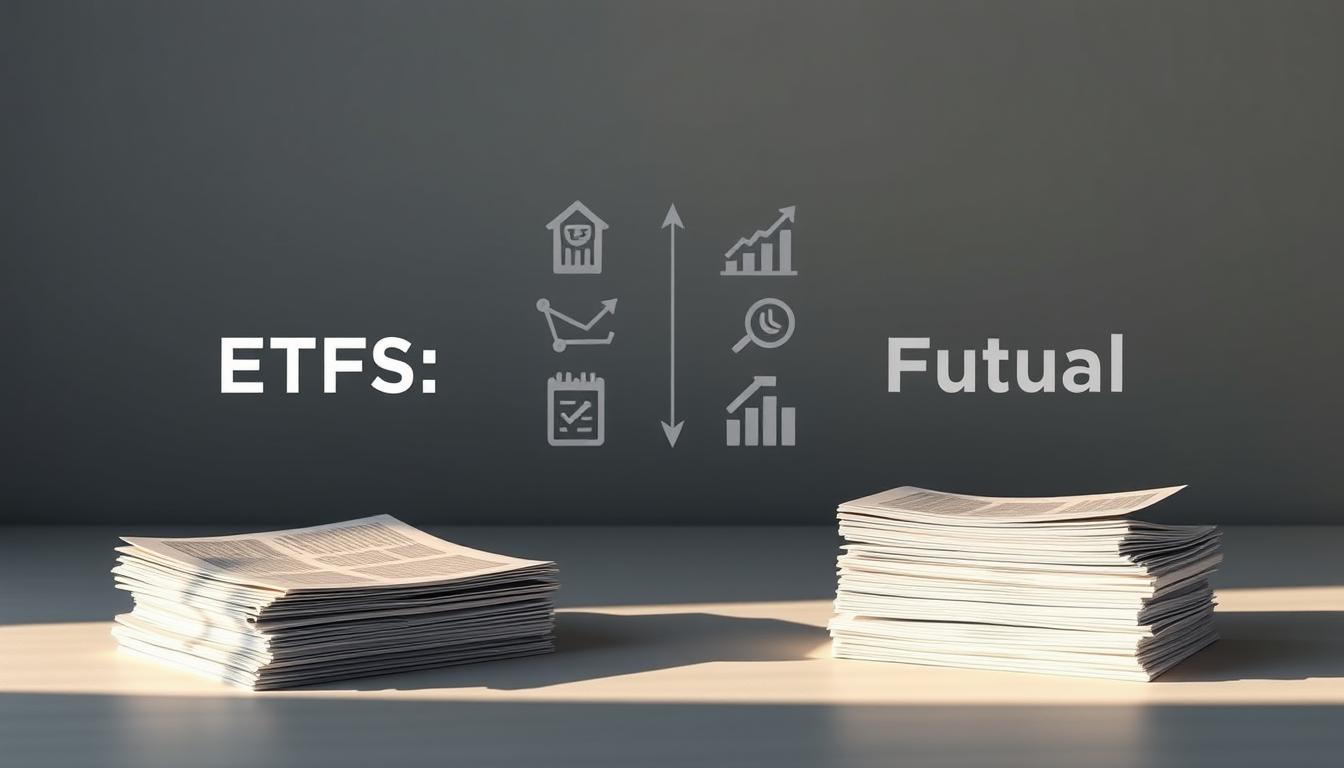Choosing the right assets for your portfolio can be tricky, especially when weighing options like ETFs and mutual funds. Both offer unique benefits, but their differences matter when building a strong financial strategy.
ETFs trade like stocks, giving flexibility throughout the day. They often come with lower fees and better tax efficiency. Mutual funds, on the other hand, are priced once daily and may include active management for hands-on oversight.
Popular firms like Vanguard and Fidelity provide both options, each catering to different investor needs. Understanding costs, trading rules, and tax impacts helps align choices with personal goals.
Key Takeaways
- ETFs trade like stocks, offering intraday flexibility.
- Mutual funds are priced once per day after market close.
- ETFs often have lower expense ratios than mutual funds.
- Tax efficiency tends to favor ETFs due to their structure.
- Active management is more common with mutual funds.
ETFs and Mutual Funds: Key Similarities
ETFs and mutual funds share core benefits that appeal to investors. Both pool money to buy securities, spreading risk across hundreds of assets. This built-in diversification helps stabilize portfolios.
Diversification and Professional Management
Vanguard’s S&P 500 index fund holds 500+ stocks, mirroring the market. Similarly, tech-focused ETFs bundle top companies like Apple and Microsoft. Professional managers track benchmarks, ensuring alignment with goals.
Wide Variety of Investment Options
From energy ETFs to high-dividend mutual funds, choices abound. Fidelity offers 250+ funds, while Vanguard covers niches like ESG investing. Investors can tailor holdings to their risk tolerance.
| Feature | ETFs | Mutual Funds |
|---|---|---|
| Diversification | Yes (e.g., sector ETFs) | Yes (e.g., index funds) |
| Commission-Free Platforms | Fidelity, Vanguard | Fidelity Smart Money℠ |
| Minimum Investment | 1 share | $1,000+ (varies) |
Commission-Free Trading at Major Brokerages
Fidelity and Vanguard waive fees for most ETF and mutual fund trades. This lowers costs for frequent traders and long-term holders alike.
How ETFs and Mutual Funds Differ
While both options offer diversification, their mechanics vary significantly. From trading hours to automation, these differences shape how investors build wealth.
Trading Mechanics: Real-Time vs. End-of-Day
ETFs trade like stocks, with prices updating throughout the day. Investors can use limit orders or stop-loss strategies. Mutual funds, however, settle once daily after markets close.
Charles Schwab notes, “ETF bid/ask spreads may affect costs, while mutual funds execute at a fixed NAV.” This impacts short-term traders more than long-term holders.
Investment Minimums: Flexibility vs. Commitment
Buying shares of an ETF starts at the current market price—like Vanguard’s $50/share tech ETF. Mutual funds often require $3,000+ upfront, as seen with Vanguard’s Target Retirement Fund.
Automation: Set-and-Forget vs. Hands-On
Mutual funds excel for passive strategies. Many platforms automate monthly deposits, ideal for dollar-cost averaging. ETFs require manual trading, which may suit active investors.
Tax efficiency also differs. Frequent ETF trades can trigger capital gains, while mutual funds offer steadier tax outcomes.
Trading Flexibility: ETFs vs. Mutual Funds
Trading flexibility can make or break your investment strategy, especially when comparing ETFs and mutual funds. One offers stock-like agility, while the other provides predictable execution. Knowing which suits your style helps avoid costly mistakes.
ETFs: Stock-Like Trading with Real-Time Pricing
ETFs trade like stocks, updating prices throughout the day. Investors can use advanced orders, such as limit or stop-loss, to control execution. Platforms like Fidelity’s Active Investor offer tools for timing trades.
Charles Schwab notes, “ETF premiums/discounts to NAV affect total ownership costs.” Thinly traded ETFs may have wider bid/ask spreads, adding hidden expenses.
Mutual Funds: Single Daily Price Execution
Mutual funds settle once daily after markets close. Vanguard’s cutoff is 4 PM ET—miss it, and your trade executes at the next day’s price. This suits long-term investors who prefer automation.
Order Types and Control Over Execution
ETFs allow short selling and options trading, appealing to active traders. Mutual funds lack these features but simplify dollar-cost averaging. Here’s how they compare:
| Feature | ETFs | Mutual Funds |
|---|---|---|
| Trading Window | Market hours | Once daily |
| Order Types | Limit, stop, trailing | Market only |
| Liquidity Risk | Bid/ask spreads | Stable NAV pricing |
Tip: ETFs excel for tactical moves, while mutual funds fit hands-off strategies. Weigh costs like spreads versus fees before choosing.
Cost Comparison: ETFs and Mutual Funds
Understanding costs is crucial when deciding between ETFs and mutual funds. Fees eat into returns over time, so picking the right structure matters. Let’s break down where expenses hide in each option.

Expense Ratios and Operating Costs
ETFs often win on fees. Morningstar reports passive ETFs averaging 0.07% expense ratios, while active mutual funds hit 0.59%. Vanguard’s index funds average just 0.07%, beating the industry’s 0.44%.
Mutual funds sometimes add 12b-1 fees (marketing costs) or redemption charges. Fidelity’s no-load index funds skip these, making them cost rivals to ETFs.
ETFs: Bid/Ask Spreads and Implicit Costs
Don’t overlook trading costs. Schwab notes niche ETFs can have wide bid/ask spreads. “A $0.50 spread on a $50 ETF adds 1% to your purchase,” warns a Schwab analyst. Popular ETFs like VOO avoid this issue.
Mutual Funds: Load Fees and Other Charges
Some mutual funds charge upfront loads (1–5%). Vanguard skips these, but others don’t. Always check the fine print for:
- Front-end loads (fees at purchase)
- Back-end loads (fees when selling)
- Account maintenance fees
| Fee Type | ETFs | Mutual Funds |
|---|---|---|
| Expense Ratio | 0.07% (avg.) | 0.44% (avg.) |
| Load Fees | None | 1–5% (some funds) |
| Trading Costs | Bid/ask spreads | Redemption fees |
Pro tip: Use a cost calculator. Compare NAVs and spreads to see the real price of ownership.
Tax Efficiency: ETFs vs. Mutual Funds
Tax efficiency plays a crucial role in long-term investment success. While both fund types offer diversification, their tax treatments differ significantly. Smart choices here can save thousands in capital gains over time.
Why ETFs Often Generate Fewer Capital Gains
ETFs use in-kind redemptions to minimize taxable events. For example, Vanguard’s S&P 500 ETF swaps securities instead of selling them, avoiding gains. This structure keeps tax bills low for shareholders.
Mutual Funds and Taxable Distributions
Mutual funds often trigger taxable income when managers rebalance portfolios. A Fidelity study found active funds distribute capital gains 40% more often than passive ETFs. These unexpected bills can dent returns.
Active vs. Passive Management Tax Impacts
Actively managed funds trade frequently, creating more taxable events. Schwab notes passive ETFs typically cost investors 0.5% less annually in taxes. For example, an S&P 500 ETF outperformed an active large-cap fund after taxes in 2023.
Tip: Pair active mutual funds with tax-deferred accounts (like IRAs) to offset liabilities. Passive ETFs work well in taxable brokerage accounts.
Active vs. Passive Management in Both Funds
Management style impacts returns more than many investors realize. While passive strategies dominate ETFs, active management thrives in mutual funds. Each approach suits different goals, from steady growth to tactical bets.
Passive ETFs: Low-Cost Market Tracking
Most ETFs follow index funds, mirroring benchmarks like the S&P 500. Vanguard offers 70+ passive ETFs with expense ratios as low as 0.03%. These funds minimize trading, reducing costs and tax hits.
Morningstar found only 23% of actively managed funds beat indices over a decade. Schwab notes, “Passive ETFs consistently outperform after fees.”
Active Mutual Funds: Hands-On Oversight
80% of mutual funds use actively managed strategies. Fidelity’s Contrafund, for example, picks stocks to beat the market. This can work in niche areas like emerging markets, where research adds value.
But pitfalls exist. High fees (0.59% average) and inconsistent performance erode gains. A 5-year comparison shows S&P 500 index funds topping 80% of active large-cap funds.
Blending Strategies for Balance
Many investors mix core passive ETFs with satellite active funds. For example:
- 70% in Vanguard’s S&P 500 ETF (VOO)
- 30% in Fidelity’s emerging markets mutual fund
| Feature | Passive ETFs | Active Mutual Funds |
|---|---|---|
| Average Expense Ratio | 0.07% | 0.59% |
| Outperformance Rate | 77% (vs. benchmark) | 23% (Morningstar) |
| Best For | Long-term, tax-sensitive | Niche markets, tactical plays |
Tip: Use passive funds for core holdings and active picks sparingly. Rebalance annually to control risk.
Which Fund Type Is Right for You?
Your financial goals should guide whether you pick ETFs, mutual funds, or a mix of both. Each excels in different scenarios, from day trading to hands-off wealth building.
ETFs: Trading Flexibility and Tax Sensitivity
ETFs suit active traders and tax-conscious investors. Schwab recommends them for their real-time pricing and in-kind redemptions, which minimize capital gains. Use limit orders to control entry/exit points.
Vanguard’s 2025 update will allow automated ETF investments, bridging a key gap with mutual funds. This could reshape long-term strategies.
Mutual Funds: Automation and Niche Strategies
Mutual funds shine for set-and-forget investors. Fidelity’s Smart Money℠ program automates deposits, ideal for dollar-cost averaging. They also offer access to actively managed sectors, like emerging markets.
However, watch for higher fees. Some funds charge 1–5% loads, eroding returns.
Combining Both for Optimal Diversification
Blending ETFs and mutual funds balances flexibility and stability. For example:
- 70% in low-cost ETFs (e.g., Vanguard S&P 500)
- 30% in active mutual funds (e.g., Fidelity Contrafund)
| Scenario | Best Choice | Why? |
|---|---|---|
| Day trading | ETFs | Intraday pricing, advanced orders |
| Retirement savings | Mutual funds | Automation, steady NAV |
| Taxable accounts | ETFs | Lower capital gains distributions |
Final tip: Keep it simple. Use index funds for core holdings and add niche picks sparingly to manage risk.
Conclusion
Building wealth efficiently means matching fund types to your strategy. ETFs excel for low-cost, tax-smart trading, while mutual funds simplify automated investing.
Consider blending both in your portfolio. Use ETFs for liquidity and mutual funds for hands-off growth. Tools like Vanguard’s comparison calculator can help personalize choices.
Finally, audit your holdings. Weigh fees, tax impacts, and how each fits your market goals. Small tweaks today can boost returns tomorrow.
FAQ
How do ETFs and mutual funds differ in trading?
ETFs trade like stocks with real-time pricing, while mutual funds execute trades once per day at the net asset value (NAV).
Which has lower costs: ETFs or mutual funds?
ETFs often have lower expense ratios, but bid/ask spreads can add costs. Mutual funds may charge load fees or higher operating expenses.
Are ETFs more tax-efficient than mutual funds?
Yes, ETFs typically generate fewer taxable events due to their structure, while mutual funds may distribute capital gains annually.
Can I automate investments with ETFs like mutual funds?
Most brokerages allow automatic investing in mutual funds, but ETF automation depends on the platform (some fractional shares may be available).
Do ETFs or mutual funds perform better?
Performance depends on the underlying assets and management style. Passively managed index funds (ETFs or mutual funds) often outperform actively managed ones.
Which is better for beginners?
Mutual funds may be simpler for dollar-cost averaging, while ETFs offer more flexibility for hands-on investors.
Can I hold both ETFs and mutual funds in one portfolio?
Absolutely! Many investors use ETFs for core holdings and mutual funds for specialized strategies or automated trades.


